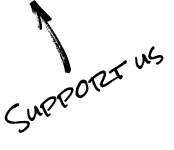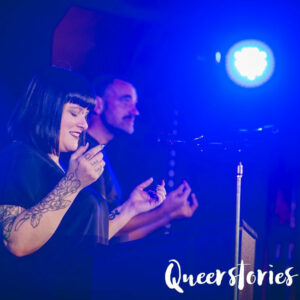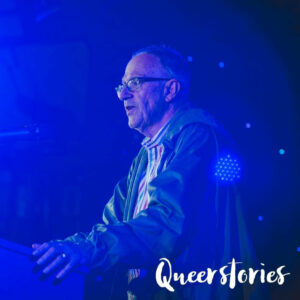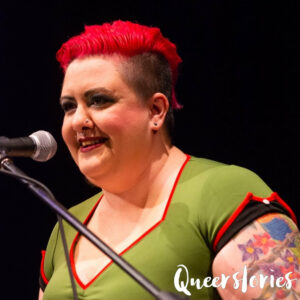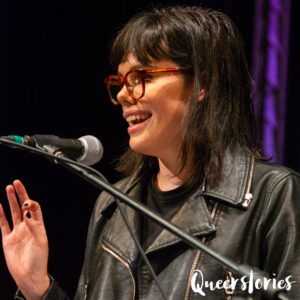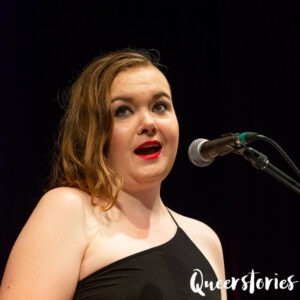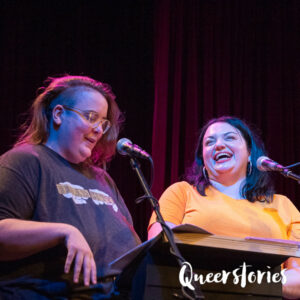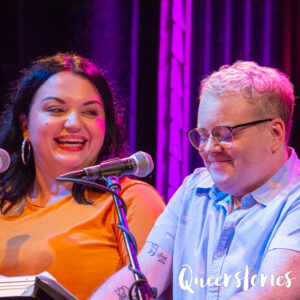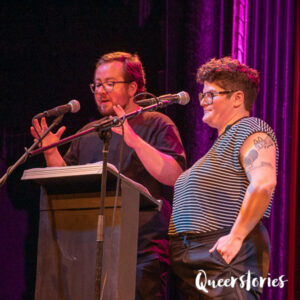Maeve: Hi, I’m Maeve Marsden and you’re listening to Queerstories. This week Dr Joni Sytsma is an aerospace engineer who began her career at the United States Air Force Research Laboratory before moving to Australia to join the Hypersonic International Flight Research Experiment program with Defence Science and Technology group. Today, Dr Sytsma is the Chief Technology Officer of the Innovative Launch, Automation, Novel Materials, Communications and Hypersonics program, a collaboration between Universities and Industry to develop Australia’s sovereign space capability.
Joni: Thanks for that Maeve, that was really nice!
I’m a 41 year old aerospace engineer, and I developed weapons for the US Air Force in the deep south for a decade before moving to Brisbane in 2016. My experiences of how LGBT folks were treated in the Air Force weren’t great, and I was looking for a change so I could bloom in safety. I landed a secondment to DST to launch rockets under the HiFIRE program. HIFiRE was special because it launched a rocket with defence relevant science experiments to over 5 times the speed of sound, or 2 km/sec, every year. The secondment was an amazing opportunity to get some hands-on rocket launching experience, and it was an opportunity to transition while I was here, in Australia.
I think my boss liked me after we launched HIFiRE 4 and I was selected to be the scientific lead of HIFiRE 7b and that meant that this rocket was my baby. I was responsible for many things, most notably the primary experiment… That I can’t talk about, so I had to do all the science behind it to prove that it was going to work; trust me, I know what I’m doing. I had to manage all the stakeholders in this program and that meant, the people we were buying the rocket from, the German aerospace corporation but it was manufactured in Brazil by another corporation, then it had to be transferred to Woomera SA by another organisation and then there’s the range safety, and then the range itself and then DST, the larger government defence and a few cats and dogs that I had to wrangle to basically make all that happen.
What nobody else knew is that basically from day one of this program I had been gender transitioning and nobody knew because I was trying to keep that a bit of a secret. I knew a few people who did this in the US Air Force base and their careers were basically damaged beyond repair. We’re talking the early days after the “don’t ask don’t tell” had been rescinded, it didn’t mean it was actually rescinded. Same-sex marriage was still illegal in the US.
When I got over here, it was so much safer and easier but I was nervous because it was a secondment, I’m supposed to go back and I excepted my career to be wrecked in addition to the normal physical violence that you read about all the time. I was desperate to find a way to stay in Australia, basically I was afraid if word got out something bad would happen about it.
So the rocket was a super exciting! It started off with my boss and friend Alan Paul and I sitting on his sailboat anchored off of Moreton Island, drinking wines and literally drawing sketches on the back of an envelope, because that’s how all science happens. Allan is a visionary rocket scientist, he’s launched over 14 rockets with UQ and DSTG. He’s pushed the limits of technology significantly and he’s still at it. He’s got a couple more rockets he’s planned and I wanna play with them. He built his sailboat over 7 years, and I lived on a sailboat for 9 years so when you get two rocket scientist that are also sailors on a boat you become friends.
So we get back to the office, we kicked off the program with a flurry of activity. We had to buy all the things and get all the metal cut. Basically what we were putting together was a rocket that is 7.5 meters long and weighs a couple tons, but my actual part of it was just the tip. It’s a 3-meter-long pointy end of the rocket that’s about 600 mm in diameter. After we completed all the planning activities then we moved onto the next fun part, we formally call it vehicle integration, I refer to it as rocket surgery but more commonly rocket proctology. So this is where you take all the pieces of metal, computer and wire and plumbing and you put it together because you start off with a pile of components and then you end with the thing that looks like the pointy end of the rocket. So we matured this system from a pile of components to something that looked like it was ready to fly. There’s a lot of frantic activity, I’ll tell you my daily – take it apart, put it back together, take it apart, put it back together, test this, test that, wire this up, is it working? No, it’s not working. The valves are leaking, we got to fix the valves.
We basically had to test one system after another and honestly everything’s broken the first time you do it and sometimes the second time you do it, so I learned a lot about accepting failure and keep moving forward no matter what. To add to the fun, I was in that new transition phase where the hormones are starting to do their magic which brings mood changes, and I tried to keep it to myself and just focus on ‘I’m going to launch a rocket’, at least I got to let my friends know.
So we got this payload to like 95% complete, we pushed into the next big phase which is qualification testing. When you qual test you shake it, you shock it. We spun it on a spin test to spin balance it, we had to go back and forth and fixing things. We had to put all the computers in there and run them in a vacuum because things tend to fail when you stick it in a vacuum. Then we put it through thermal cycle to make it really hot and really cold and we did that like 20 times just to try and break it because the point of qualification is to try and break it on the ground so it doesn’t break in the air.
This is nerve wracking, when I break something on the ground, it’s my job to fix it because that’s what I do and that gives me an emotional roller coaster because everyday I go into work and am like “Ok, I’m gonna test this thing!” And if I break it, it’s my problem. One time we put it on the vibe table and this is like the finally vibration and we put it through the program to shake it and it’s going “whoop, whoop, whoop!” Then all of a sudden we heard “Ting, ting, ting, ting, ting, ting!” Inside and I just about to cry because it took us two weeks to put this thing together and now I have to take the whole thing apart, strip it down to nothing and put it back together again. It’s not a good feeling. But, in rocket science, you must accept failure and keep on moving and that’s the rocket business!
This fever pitch of work led up to a crescendo where it’s t-munis zero in terms of we’re about to leave the building. There’s a drop-dead decision that the whole team has to decide are we a go or a no-go and lucky us, it was green all across the board. We packed up my baby in a crate and shipped it off to Woomera in South Australia, not to see it again for another month.
I don’t know if you know much about Woomera, it’s not a great place, that’s why we launch rockets there. I went from 10 months of frantic activity, focusing on my baby then suddenly it’s not there anymore and there’s nothing for me to do, there’s not rocket anymore. Did I fix that thing? There’s a thousand things you doubt and the only thing you can do is come up with a plan for when you get do to Woomera so you can check these things. A month of planning, then all of a sudden I’m in Woomera with the team. Unpacking, testing everything. You know, you’d like to think that we tested it comprehensively but we had last minute excitement where the navigational system, the thing to tell it where to go didn’t work and that’s a potential mission killer. I was a bit stressed out. So as anybody in the software world might know I’m gonna say that we made an oops and we skipped some testing because of you know, time and schedule and people and all those things. And then that’s what came around to bite us. So we had to revamp substantial bits of that rocket and get it ready to fly no matter what because that’s basically how it had to be. Then we were getting to the count down. The clock is like t-minus 5 days then all of a sudden it’s “are we launching today?” But we didn’t launch today. We had to wait a whole week because the wind was just howling and you can’t launch in a wind hold. Finally we get to the point, we’re at the count down. All this work, 10 months of high paced activity and then here we are and I’m the lead so I get to do the count down and my hearts beating out of my chest as I say “T-minus 5, 4, 3, 2,” Do you understand what this feels like? It’s like this moment I wish I could crystallise and frame it on the wall because I just felt like, this is over. And then it’s flying and I’m watching the telemetry streams and I’m just thinking to myself, ‘It’s gonna succed of fail in 30 seconds’ because that’s how long it takes to get to the primary experiment. And then the whole mission itself is 2 minutes and everybody’s clapping. And that’s it, it’s over.
Well, we lit the candle, it flew away from us rapidly and the mission was a success. We had a big party, and many beers were consumed. The next day we got to go recover the payload, which was squished and then go back home. This was the end of my secondment so theoretically I’m going back to the deep south to work for the Air Force again.
I’m a little bit lucky and while I was there I had a chat with Adam Gilmour and had a job interview lined up with him and I later became the head of Guidance Navigation and Control at Gilmour which is a real cool gig. I got to stay in Australia and I’ve been here ever since, I’m a citizen now. I came out on the job with Adam at Gilmour Space, everything went completely well and we launched a could rockets there, one of them blew up… But that’s another story. Thank you for listening.
Maeve: Thanks for listening! Please subscribe to the podcast, share your favourite tales on the socials and follow Queerstories on Facebook for updates. If you enjoy Queerstories, consider supporting the project on Patreon. Check out the link in the episode description. Finally, for late night ramblings, gay shit and photos of me trying to garden with a baby on my back. Follow Maeve Marsden on Twitter and Instagram.



